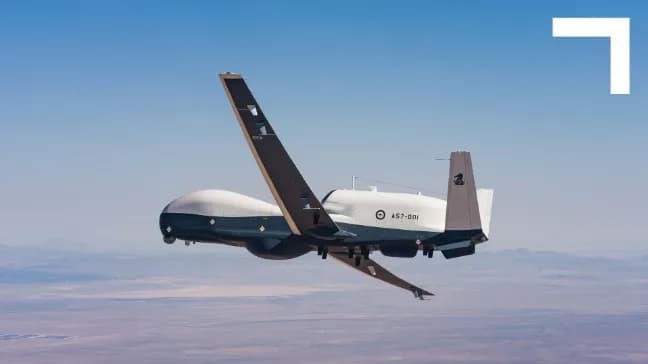Description

Disclaimer: Copyright infringement not intended.
Context
- The first Northrop Grumman MQ-4C Triton uncrewed aerial vehicle (UAV) destined for Australia has made its initial flight.
- Northrop said it has completed the inaugural sortie with Canberra’s first Triton intelligence collection aircraft at the company’s aircraft integration centre in Palmdale, California.
Details
- The MQ-4C Triton is a high-altitude, long-endurance (HALE) unmanned aerial vehicle (UAV) developed by Northrop Grumman for the United States Navy.
- It is designed to provide maritime intelligence, surveillance, and reconnaissance (ISR) capabilities.:
Overview
- Manufacturer: Northrop Grumman developed the MQ-4C Triton as part of the Broad Area Maritime Surveillance (BAMS) program for the U.S. Navy.
- Purpose: The Triton serves as a critical asset for maritime missions, providing persistent surveillance over vast oceanic regions to support various missions such as maritime intelligence gathering, reconnaissance, surveillance, and target acquisition.
Design and Capabilities
- High-Altitude Long-Endurance (HALE): The MQ-4C Triton is designed for extended missions at high altitudes, allowing it to cover large maritime areas for an extended duration without the need for frequent refueling.
- Size and Specifications: With a wingspan of around 130 feet (39.6 meters), the Triton is comparable in size to a commercial airliner. It is equipped with state-of-the-art sensors and radar systems.
- Sensor Suite: The Triton is fitted with various advanced sensors, including an active electronically scanned array (AESA) radar, electro-optical/infrared (EO/IR) cameras, and electronic support measures (ESM) systems for comprehensive surveillance capabilities.
- Communication and Data Relay: It has a robust communication suite allowing real-time data relay to naval command centers, facilitating quick decision-making based on collected intelligence.

Operational Capabilities
- Maritime Surveillance: The primary role of the Triton is to conduct broad-area maritime surveillance, monitoring surface vessels, providing coastal and overland surveillance, and enhancing maritime domain awareness.
- Mission Duration: It can operate for up to 24 hours at a time, covering vast distances over maritime regions, and can be re-tasked for various missions during flight.
- Complementary Operations: The MQ-4C Triton operates in conjunction with other maritime assets, including manned aircraft, surface ships, and submarines, enhancing the overall maritime surveillance and reconnaissance capabilities of the U.S. Navy.
Advantages and Significance
- Persistent Coverage: The Triton's endurance and advanced sensor suite allow for persistent surveillance, significantly enhancing the Navy's ability to detect, track, and classify targets of interest over extended periods.
- Reduced Risk to Crew: Being unmanned, the Triton reduces the risk to human lives during long-duration missions, particularly in challenging maritime environments.
Challenges and Development
- Technological Advancements: Continuous advancements in sensor technology and data processing are necessary to maintain Triton's relevance and effectiveness in an evolving threat landscape.
- Integration and Adaptability: Ensuring seamless integration with existing naval systems and adapting the platform to meet evolving operational requirements and emerging threats is an ongoing challenge.
Conclusion
The MQ-4C Triton stands as a critical asset in the U.S. Navy's arsenal, providing persistent maritime surveillance and reconnaissance capabilities. Its advanced sensor suite, endurance, and ability to cover vast oceanic regions make it an invaluable tool for enhancing maritime domain awareness and supporting various naval missions. However, continuous technological advancements and adaptations are crucial to ensuring its effectiveness in modern naval operations.
|
PRACTICE QUESTION
Q. Which of the following statements is true regarding the MQ-4C Triton drone?
A) It is a ground-based surveillance system developed for monitoring urban areas.
B) The Triton is a low-altitude, short-endurance UAV primarily used for agricultural purposes.
C) MQ-4C Triton is a high-altitude, long-endurance unmanned aerial vehicle designed for maritime surveillance missions by the U.S. Navy.
D) It is an experimental spacecraft developed for deep-space exploration missions by NASA.
Answer: C)
|










